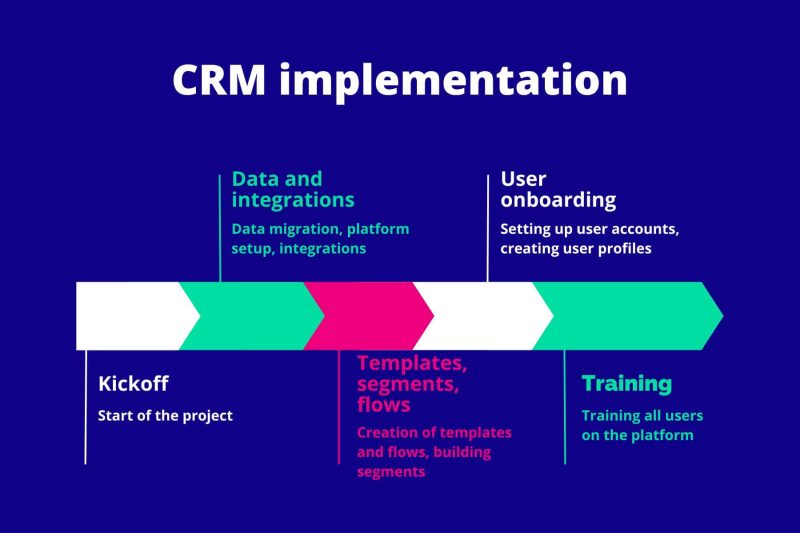The importance of user adoption in a CRM platform
These days, everyone seems to be constantly on the lookout for the newest tools. It’s as if your company can only survive if it jumps on every new thing in marketing every single time. And though we do encourage innovation, and even though the world is evolving rapidly, we still feel that too much importance is placed on the tool itself. The people in your team that are actually using the tools are at least as important.
Unfortunately, a lot of organizations just look at setting up that new tool. They seem to think all it takes for your organization to actually grow, is to just create an account. As if everything after that is automatically just going to happen. We could not be further from the truth. Don’t get us wrong: the right platforms and tools are definitely going to help you grow. All we’re saying is that it takes time and effort to actually reap all the benefits from the tools. In this blog post we’ll focus on the importance of user adoption in a CRM platform.
What is user adoption?
User adoption is the process that new users go through when they start using a new product. The product here could be anything. User adoption starts the day your organization orders the product or service. It entails not only creating user accounts for your team, but also making sure that everybody uses it as efficiently as possible. And you guessed it: this is where problems start to arise.
Companies that start using a new accounting tool, VoIP system or marketing platform all do it to gain something. It could be more productivity, more collaboration or lower costs. Whatever the goal may be, your organization will never reach it without actively maximizing user adoption. This is what makes or breaks the success of any tool or platform you will ever implement. In fact, without user adoption, you can’t even claim implementation at all in our opinion.
How user adoption benefits the organization
More productivity
By far the most obvious benefit of user adoption is the increased productivity, both on an individual and on a team level. Team members with a high degree of user adoption tend to use significantly more features in the platform than others. They are also more likely to use everything the way it was intended to be used. This significantly increases the effectiveness of the platform and therefore also the platform’s ROI.
Research shows that with proper onboarding, 68% of end users in an organization use the platform more productively. On top of that, 56% use more features, and 87% are able to work more independently, as in ‘not needing their hand to be held’ when actually using the platform. All of that combined makes for a large increase in productivity.
Customer satisfaction
Logic dictates that as you use a CRM platform more effectively, your customers will end up having a better user experience because of it. That goes for all stages in the buyer or customer journey, whether they are just a prospect or paying customer.
So let’s say your sales team starts talking to a lead in your CRM platform. If your marketing team has used the CRM platform effectively, it will contain a lot information about interactions with the prospect. Your sales team will be able to better prepare their pitch, sales documentation and demo’s. This will increase the likelihood of your prospect actually trusting your organization and your solution, and ultimately buying from you.
Data and analytics
Good onboarding and user adoption will also lead to higher data quality and more thorough analytics. If your team uses the full potential of the platform, this will create more data and increase the quality of the data in your platform. And users that understand the platform really well will be able to better interpret data and it’s origin and meaning. In the end, all of this will enable your teams to take better decisions to further grow your organization.
Streamlined collaboration and communication
Teams that are properly onboarded on a CRM platform will experience a higher degree of collaboration and communication as well. User adoption is a key factor in improving collaboration and communication within organizations. When employees are trained and encouraged to use a platform, it becomes easier to share information, track progress, and coordinate their activities. It enables teams to communicate more efficiently, reducing the need for multiple rounds of email exchanges or in-person meetings. Additionally, user adoption helps to break down silos, allowing for better cross-functional collaboration and teamwork.

Factors negatively affecting user adoption
Resistance to change
A very common one is resistance to change. Humans are generally not very good at dealing with change: we are afraid of the unknown. Most people can’t deal with the stress and anxiety, so they stick to what they know. Change can disrupt familiar routines, relationships, and comfort zones, leading to feelings of discomfort and insecurity. Your team members may also fear change due to past experiences that may have resulted in negative outcomes. However, it is important to recognize that change can lead to growth and new opportunities. And with the right approach and mindset, people can overcome the fear of change. Hence the importance of good onboarding processes and training.
Lack of user engagement
Another common issue is the lack of engagement from individuals in your teams. A tool is just an empty box if it is not being used. The quality of the output of any system depends very much on the input and on the way users engage with the tool. In a CRM platform, your sales team can only reap the benefits from whatever is in the tool if everybody else in the team has been using the platform consistently. For example, it will be hard for your team to upsell something if other team members neglect to input relevant data in the CRM platform.
Poor training and support
Neglecting to train or support your people on a new platform almost guarantees you that user adoption will be very low. First of all, if users are not properly trained on how to use the platform, they may not be able to effectively use all features. This can lead to frustration and a lack of confidence in using the platform. Second, if users don’t get sufficient support, they will likely run into issues and not know how to resolve them. We see this leading to decreased productivity and an increase in downtime in many cases. Additionally, a lack of training and support can cause low engagement and adoption levels, leading to a lack of buy-in and resistance to change. Furthermore, it can also cause incorrect usage of the platform, poor data quality and incorrect insights. Ultimately, this will all seriously hinder the success and adoption of the platform within your organization.
Strategies and tactics to increase user adoption
Create a culture of user adoption
Admittedly it’s not the easiest thing to do in your organization, but creating a culture of user adoption will have a positive effect on how well users adopt a new platform. This is true in general, not just for CRM platforms.
Empower users
Empowering users to take control of their own experience with a CRM platform helps increase user adoption in several ways. First of all, it gives users a sense of ownership and autonomy over their data and interactions, which helps them get more confident. Second: empowering users to make decisions about their own experience leads to more accurate and meaningful data, as well as a more personal and tailored experience. Lastly, empowering users to troubleshoot and solve problems on their own encourages a culture of self-sufficiency and reduces the burden on support. This will free up time and resources to focus on more strategic initiatives.
Offer incentives or rewards
Incentives or rewards can have a positive effect on user adoption as well. By offering rewards for active use of the platform, users are motivated to log in and use the available features. This not only helps them better understand the platform’s capabilities, but it also encourages them to make the platform a regular part of their work routine. Additionally, incentives help foster a positive perception of the platform and its value, further encouraging its continued use. IF you choose to reward people though, be smart about the conditions for a reward. You should also formulate them as clearly as possible in order to avoid discussions afterwards.
Continuous improvement and feedback
Continuous improvement and feedback are key drivers of user adoption in a CRM platform. Regularly collecting and analyzing feedback from users helps identify areas of improvement and ensure that the team keeps striving to get the most out of the platform. This not only helps increase user satisfaction and engagement. It also builds trust and credibility, as users can see that their voices and suggestions are being heard and acted upon. As a result, the CRM platform becomes more effective, increasing the likelihood of user adoption as well as the platform’s ROI.
Effective onboarding and training
When investing in a CRM platform, fight the urge to skip onboarding or training. A well-structured onboarding process helps new users understand the platform’s features and benefits, and how it can help them in their daily tasks. Training sessions provide an opportunity for users to learn about the platform’s functionalities in a hands-on environment, ask questions and get support from experts. By providing proper onboarding and training, your organization ensures that its users are equipped with the necessary knowledge and skills to effectively use the platform. This leads to higher user adoption rates and better results for your organization.
If you are thinking about investing in a CRM platform, or if you have already started using one, you may want to put time and effort in onboarding your users. This can significantly improve your organization’s overall customer experience and increase customer satisfaction. Maybe this will cost you more in the short term, but your team will be so much more productive when using the platform. The long-term benefits of a successful CRM implementation will make the investment well worth it.
The ultimate marketing automation guide
Ready to save your company a lot of money by automating your marketing and sales? Get started with our FREE marketing automation guide!






